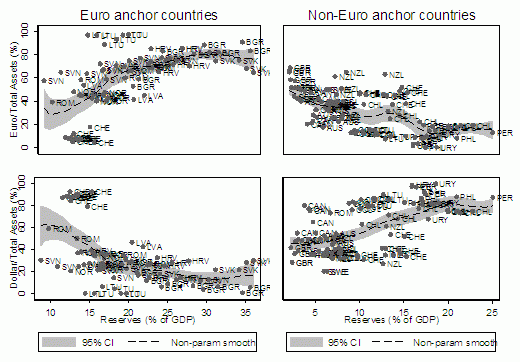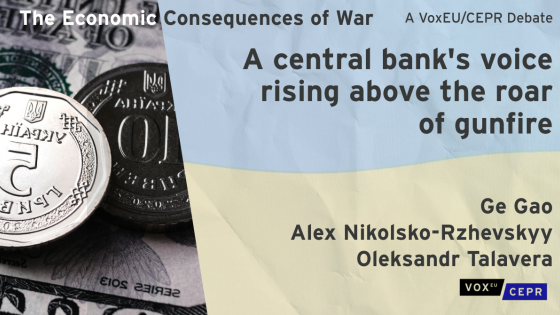The notable increase of foreign-exchange reserve holdings by emerging market central banks was only temporarily interrupted during the 2008/2009 crisis. At the end of 2009, reserves held by emerging market central banks stood at $5.3 trillion, a five-fold increase over the past decade and close to $300 billion above the pre-crisis peak level.
Such large reserve holdings typically bring with them opportunity costs.
- The return on low-yielding US government bonds is lower than alternative domestic investment opportunities (Rodrik 2006).
- Reserves have started to exceed most conventional metrics of reserve adequacy (Jeanne and Ranciere 2008, Obstfeld et al. 2008).
These observations have steered the policy debate on reserves into three main directions.
- According to the first argument, reserves have grown too large as a by-product of a policy to keep exchange rates undervalued and boost net exports. Consequently, the exchange rates of the respective countries should become more flexible, in particular in the case of China, to allow a global re-balancing.
- A second argument in the policy debate suggests that large reserve holdings by emerging markets could perhaps be substituted to some extent by alternative safety nets such as swap lines and SDRs.
- The third argument, which is implicitly taking the level of reserves as given, argues reserve portfolios should become more diversified. Since reserve levels exceed common reserve adequacy ratios, this would reduce the implicit opportunity cost of the (excess) reserves.
Yet the empirical evidence supporting the idea that reserve portfolios should become more diversified has been scarce. According to IMF data, aggregate currency shares in global reserves have remained relatively stable over the past years, despite large increases in reserve levels.
The available evidence from countries which publicly disclose data on their reserve composition suggests that higher reserve levels might even be associated with less diversified reserve portfolios. In fact, as documented by Beck and Rahbari (2008), euro (dollar)-oriented countries hold larger shares of their reserve portfolio in euros (dollars). In addition, this share appears to be increasing with the level of reserves relative to GDP (see Figure 1).
Figure 1. Reserve portfolios and currency anchors
Source: Beck and Weber (2010).
Notes: The countries shown in the charts are Australia, Bulgaria, Canada, Chile, Columbia, Croatia, Iceland, Latvia, Lithuania, New Zealand, Norway, Peru, Philippines, Romania, Slovak Republic, Slovenia, Sweden, Switzerland, UK, and Uruguay. Data points refer to pooled annual observations with varying start dates ending in 2007. Local polynomial regressions of the portfolio shares of the safe asset on reserves-to-GDP ratios are shown as solid line with shaded areas representing 95% confidence intervals
Using local polynomial regressions of the currency shares on the reserve ratio suggests that there is a clear positive link between the reserve ratio and the allocation of reserves into the safe asset. Countries which anchor to the euro tend to increase the euro share as the level of reserves increases (top left panel) while other countries tend to do the contrary (top right panel)1. The results for the dollar share mirror this pattern. Euro anchor countries (bottom left) reduce their exposure to dollar assets as the reserve ratio increases, while other countries increase their share of dollar holdings as they hold more reserves (bottom right).
New insight on reserve accumulation and diversification
In a recent paper (Beck and Weber 2010), we propose a possible explanation for such a negative relationship between reserve accumulation and reserve diversification. We show that, depending on the underlying motives behind the increase in reserves, reserve diversification may be optimal or not. In a model in which optimal reserve levels and their optimal composition are determined jointly, a rise in reserves which is driven by precautionary motives leads to reserve portfolios with a larger optimal share of the “safe asset”. An exogenous rise in reserves leads to more reserve diversification, however.
The basic mechanism behind our results is simple. Higher reserve holdings lower the probability of a crisis. Therefore, as a central bank increases its reserve holdings, the expected additional cost of having to intervene in a currency which is not the anchor currency is relatively small compared to the gains of diversification, since this cost is only paid in the advent of a crisis whereas diversification gains are made in all other circumstances. Hence, an exogenous increase in reserves triggers increased reserve diversification. However, if reserve increases are driven by higher risk aversion the subjective weight on the intervention scenario outcome increases. Consequently, diversification may not always be optimal despite an increase in reserves.
In an empirical application, we first show that the rise in reserves in our sample of 20 countries is mainly driven by “precautionary motives”, approximated by three standard indicators, namely capital-account openness, the imports-to-GDP ratio, and exchange-rate anchoring. Taken together, these factors explain more than 50% of the variation in reserve holdings and are in line with findings by Aizenman and Lee (2007) and Obstfeld et al. (2008). Therefore, it is reasonable to expect that the rise in reserves in these countries has been associated with larger allocations to the “safe asset”, i.e. the euro for countries anchoring to the euro and the dollar for countries anchoring to the dollar2.
This intuition is confirmed when we regress the currency share of reserves on potential determinants, including the part of reserve accumulation which is associated with these three precautionary motives. We find in the second stage regression that the dollar share is positively and significantly related to the precautionary part for dollar anchoring countries while the euro share is significantly increasing in the precautionary part for euro anchoring countries. For countries that anchor to the dollar, the remainder part of the reserve increase (i.e. the residual from the first stage) is instead negatively correlated with the safe asset while it is positively related to the euro share. This provides some evidence that an exogenous rise in reserves – i.e. one that is not driven by precautionary but for example mercantilist or other motives – leads indeed to more reserve diversification.
Our results may provide insight to the behaviour of sovereign wealth funds that have been created to manage “excess reserves” more actively than traditional central banks in order to achieve higher returns. While little precise information about the asset holdings of such national investment vehicles is available, the evidence we do have access to suggests that these funds have more diversified portfolios than traditional central banks. To the extent that the holdings of sovereign wealth funds can be interpreted as the part of reserve holdings which is not driven by pre-cautionary motives, these stylised facts seem to be in line with the predictions of our model.
Disclaimer: The views expressed in this column are those of the authors and do not necessarily reflect those of the European Central Bank.
References
Aizenman, Joshua and Jaewoo Lee (2007), “International Reserves: Precautionary Versus Mercantilist Views, Theory and Evidence”, Open Economies Review, 18(2):191-214, April.
Beck, Roland and Ebrahim Rahbari (2008), “Optimal reserve composition in the presence of sudden stops – the euro and the dollar as safe haven currencies”, ECB Working Paper 916, European Central Bank, July.
Beck, Roland and Sebastian Weber (2010), “Should Larger Reserve Holdings be More Diversified?”, ECB Working Paper 1193, May.
Rodrik, Dani (2006), “The social cost of foreign exchange reserves”, International Economic Journal, 20(3), 253-266, November.
Jeanne, Olivier and Romain Rancière (2008), “The Optimal Level of International Reserves For Emerging Market Countries: A New Formula and Some Applications”, CEPR Discussion Papers 6723, February.
Obstfeld, Maurice, Jay C Shambaugh, and Alan M Taylor (2008), “Financial Stability, the Trilemma, and International Reserves”, CEPR Discussion Papers 6693, February.
Reinhart, Carmen M, and Kenneth S Rogoff (2004), “The modern history of exchange rate arrangements: A reinterpretation”, The Quarterly Journal of Economics, 119(1): 1-48.
1 A country is considered as anchoring to the euro if it is not considered floating by the IMF and ranked by Reinhart and Rogoff (2004) as maintaining some form of a peg to or band around the euro.
2 The dollar anchor is defined analogous to the euro anchor. The baseline group in the estimation are countries which are de facto and de jure floating.



